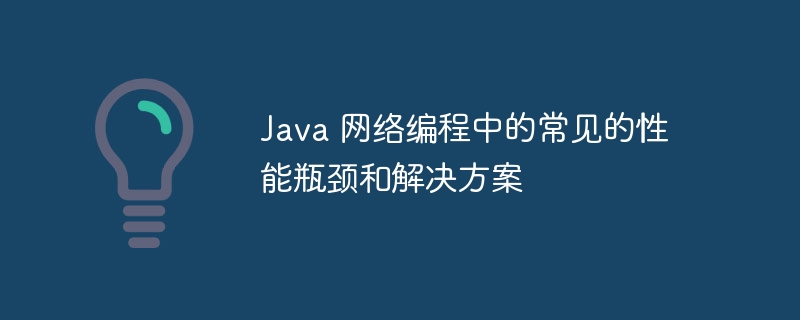
Common performance bottlenecks in Java network programming include: blocking I/O, high concurrent connections, slow networks, and poor code efficiency. Solutions include: using non-blocking I/O, connection pooling, data compression, and code optimization. For example, optimizing server-side network performance using NIO non-blocking I/O can improve throughput and response time because it allows multiple client connections to be handled simultaneously.

In Java network programming, performance optimization is crucial because it directly affects the application response speed and user experience. The following are some common performance bottlenecks and their solutions:
Bottleneck: Blocking I/O operations block threads during request processing. Leading to program inefficiency.
Solution: Use non-blocking I/O, such as Java NIO or asynchronous I/O, to allow the application to continue processing other tasks while waiting for the I/O operation to complete.
Bottleneck: A large number of concurrent connections will cause too many open file handles, thus exhausting system resources and causing the program to crash.
Solution: Use a connection pool to manage connections and limit the number of concurrent connections.
Bottleneck: Network latency or bandwidth limitations can cause applications to respond slowly, especially when processing large amounts of data.
Solution: Use data compression technology to reduce the amount of data, and use efficient data transfer protocols, such as HTTP/2.
Bottleneck: Inefficient code implementation will cause unnecessary overhead and affect performance.
Solution: Follow best practices such as avoiding unnecessary object creation, optimizing algorithms, and using caches correctly.
The following is an example of using NIO non-blocking I/O to optimize server-side network performance:
import java.io.IOException;
import java.net.InetSocketAddress;
import java.nio.ByteBuffer;
import java.nio.channels.SelectionKey;
import java.nio.channels.Selector;
import java.nio.channels.ServerSocketChannel;
import java.nio.channels.SocketChannel;
import java.util.Iterator;
public class NonBlockingEchoServer {
private static final int BUFFER_SIZE = 1024;
public static void main(String[] args) throws IOException {
ServerSocketChannel serverSocketChannel = ServerSocketChannel.open();
serverSocketChannel.bind(new InetSocketAddress(8080));
serverSocketChannel.configureBlocking(false); // 设置为非阻塞
Selector selector = Selector.open();
serverSocketChannel.register(selector, SelectionKey.OP_ACCEPT);
while (true) {
selector.select();
Iterator<SelectionKey> keys = selector.selectedKeys().iterator();
while (keys.hasNext()) {
SelectionKey key = keys.next();
keys.remove();
if (key.isAcceptable()) {
handleAccept(selector, serverSocketChannel);
} else if (key.isReadable()) {
handleRead(key);
} else if (key.isWritable()) {
handleWrite(key);
}
}
}
}
private static void handleAccept(Selector selector, ServerSocketChannel serverSocketChannel) throws IOException {
SocketChannel socketChannel = serverSocketChannel.accept();
socketChannel.configureBlocking(false);
socketChannel.register(selector, SelectionKey.OP_READ);
}
private static void handleRead(SelectionKey key) throws IOException {
SocketChannel socketChannel = (SocketChannel) key.channel();
ByteBuffer buffer = ByteBuffer.allocate(BUFFER_SIZE);
int readBytes = socketChannel.read(buffer);
if (readBytes > 0) {
buffer.flip();
// 处理收到的数据
}
}
private static void handleWrite(SelectionKey key) throws IOException {
SocketChannel socketChannel = (SocketChannel) key.channel();
// 处理准备发送的数据
int writeBytes = key.channel().write(ByteBuffer.wrap("响应数据".getBytes()));
}
}By using NIO and non-blocking I/O, the server Can handle multiple client connections simultaneously, improving throughput and response time.
The above is the detailed content of Common performance bottlenecks and solutions in Java network programming. For more information, please follow other related articles on the PHP Chinese website!
